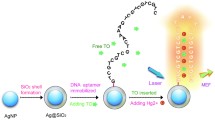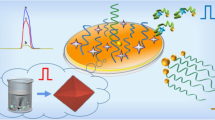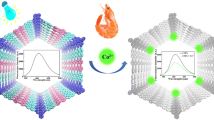Abstract
A robust “on–off” fluorescent aptasensor was developed using nanohybrids of molybdenum sulfide (MoS2) quantum dot (QD)–doped zinc metal–organic frameworks (Zn-MOF) for selective and sensitive detection of cadmium ions (Cd2+) in water. This nanohybrid (MoS2@Zn-MOF), synthesized via “bottle around the ship” methodology, exhibited a high-intensity fluorescence emission centered at 430 nm (λEm) (blue) on excitation at 320 nm (λEx). Further, the conjugation of this fluorophore to phosphate-modified cadmium aptamer (Cd-2–2) was achieved through carbodiimide reaction. The hybridization of prepared sensing probe (MoS2@Zn-MOF/Cd-2–2 aptamer) was done with dabcyl-conjugated complementary DNA (cDNA), acting as energy donor–acceptor pair in the fluorescence resonance energy transfer (FRET) system. This hybridization causes the fluorescence quenching of the nanohybrid. In the presence of Cd2+, the aptamer from the fabricated nano-biosensing probe binds to these ions, resulting in release of dabcyl-cDNA oligomer. This release of dabcyl-cDNA oligomer from the sensing probes restores the fluorescence of the nanohybrid. Under optimized conditions (sensing probe/dabcyl-cDNA ratio 1/7, pH 7.4, and temp 28 °C), the sensing probe showed a fast response time of 1 min. The fluorescence intensity of the nanohybrid can be utilized to determine the concentration of Cd2+. The proposed aptasensor achieved highly sensitive detection of Cd2+ with a limit of detection (LOD) of 0.24 ppb over the range of 1 × 10−9 to 1 × 10−4 M along with minimal effects of interferences (e.g., Hg2+, Pb2+, and Zn2+) and good reproducibility. The designed aptasensor based on MoS2@Zn-MOF nanofluorophore offers a highly sensitive and selective approach for rapid screening of metal ions in aqueous environments.
Graphical Abstract





Similar content being viewed by others
References
Sheikh MC, Hasan MM, Hasan MN et al (2023) Toxic cadmium(II) monitoring and removal from aqueous solution using ligand-based facial composite adsorbent. J Mol Liq 389:122854. https://doi.org/10.1016/J.MOLLIQ.2023.122854
Hasan MM, Kubra KT, Hasan MN et al (2023) Sustainable ligand-modified based composite material for the selective and effective cadmium(II) capturing from wastewater. J Mol Liq 371:121125. https://doi.org/10.1016/J.MOLLIQ.2022.121125
Idrees N, Tabassum B, Abd Allah EF et al (2018) Groundwater contamination with cadmium concentrations in some West U.P. Regions. India. Saudi J Biol Sci 25:1365. https://doi.org/10.1016/J.SJBS.2018.07.005
National primary drinking water regulations | US EPA. https://www.epa.gov/ground-water-and-drinking-water/national-primary-drinking-water-regulations. Accessed 16 Aug 2022
Kasa NA, Chormey DS, Büyükpınar Ç et al (2017) Determination of cadmium at ultratrace levels by dispersive liquid-liquid microextraction and batch type hydride generation atomic absorption spectrometry. Microchem J 133:144–148. https://doi.org/10.1016/J.MICROC.2017.03.035
Figueiredo-Filho LCS, Janegitz BC, Fatibelilo-Filho O et al (2012) Inexpensive and disposable copper mini-sensor modified with bismuth for lead and cadmium determination using square-wave anodic stripping voltammetry. Anal Methods 5:202–207. https://doi.org/10.1039/C2AY26078F
Xu D, Fan W, Lv H et al (2014) Simultaneous determination of traces amounts of cadmium, zinc, and cobalt based on UV–Vis spectrometry combined with wavelength selection and partial least squares regression. Spectrochim Acta Part A Mol Biomol Spectrosc 123:430–435. https://doi.org/10.1016/J.SAA.2013.12.086
Giraldo YR, Sánchez ER, Torres LG et al (2022) Development of validation methods to determine cadmium in cocoa almond from the beans by ICP-MS and ICP-OES. Talanta Open 5:100078. https://doi.org/10.1016/j.talo.2021.100078
Almasoud N, Habila MA, Alothman ZA et al (2020) Nano-clay as a solid phase microextractor of copper, cadmium and lead for ultra-trace quantification by ICP-MS. Anal Methods 12(41):4949–4955. https://doi.org/10.1039/d0ay01343a
Lu YK, Sun HW, Yuan CG, Yan XP (2002) Simultaneous determination of trace cadmium and arsenic in biological samples by hydride generation-double channel atomic fluorescence spectrometry. Anal Chem 74(7):1525–1529. https://doi.org/10.1021/AC0156971
Tuerk C, Gold L (1990) Systematic evolution of ligands by exponential enrichment: RNA ligands to bacteriophage T4 DNA polymerase. Science 249(4968):505–510. https://doi.org/10.1126/SCIENCE.2200121
Chen C, Wang J (2020) Optical biosensors: an exhaustive and comprehensive review. Analyst 145:1605–1628. https://doi.org/10.1039/C9AN01998G
Kumar S, Jain S, Dilbaghi N et al (2019) Advanced selection methodologies for DNAzymes in sensing and healthcare applications. Trends Biochem Sci 44:190–213. https://doi.org/10.1016/J.TIBS.2018.11.001
Tan W, Donovan MJ, Jiang J (2013) Aptamers from cell-based selection for bioanalytical applications. Chem Rev 113:2842–2862. https://doi.org/10.1021/CR300468W/ASSET/IMAGES/MEDIUM/CR-2012-00468W_0018.GIF
Sefah K, Phillips J, Wu C (2015) Cell-specific aptamers for disease profiling and cell sorting. Aptamers Sel Cell-SELEX Theranostics 197–213. https://doi.org/10.1007/978-3-662-46226-3_9
Zhu Y, Wang J, Xie H et al (2022) Double signal amplification strategy for dual-analyte fluorescent aptasensors for visualizing cancer biomarker proteins. Anal Chem 94:10451–10461. https://doi.org/10.1021/ACS.ANALCHEM.2C01649/SUPPL_FILE/AC2C01649_SI_001.PDF
Yuan M, Qian S, Cao H et al (2022) An ultra-sensitive electrochemical aptasensor for simultaneous quantitative detection of Pb2+ and Cd2+ in fruit and vegetable. Food Chem 382:132173. https://doi.org/10.1016/J.FOODCHEM.2022.132173
Awual MR, Islam A, Hasan MM et al (2019) Introducing an alternate conjugated material for enhanced lead(II) capturing from wastewater. J Clean Prod 224:920–929. https://doi.org/10.1016/J.JCLEPRO.2019.03.241
Kumar S, Jain S, Nehra M et al (2020) Green synthesis of metal–organic frameworks: a state-of-the-art review of potential environmental and medical applications. Coord Chem Rev 420:213407. https://doi.org/10.1016/j.ccr.2020.213407
An JD, Wang TT, Shi YF et al (2021) Convenient ultrasonic preparation of a water stable cluster-based cadmium(II) coordination material and highly sensitive fluorescent sensing for biomarkers DPA and 5-HT. Spectrochim Acta Part A Mol Biomol Spectrosc 247:119092. https://doi.org/10.1016/J.SAA.2020.119092
Asadi F, Azizi SN, Chaichi MJ (2019) Green synthesis of fluorescent PEG-ZnS QDs encapsulated into Co-MOFs as an effective sensor for ultrasensitive detection of copper ions in tap water. Mater Sci Eng C 105:110058. https://doi.org/10.1016/J.MSEC.2019.110058
Luo X, Huang G, Li Y et al (2022) Dual-modes of ratiometric fluorescent and smartphone-integrated colorimetric detection of glyphosate by carbon dots encapsulated porphyrin metal–organic frameworks. Appl Surf Sci 602:154368. https://doi.org/10.1016/J.APSUSC.2022.154368
Li Y, Li JJ, Zhang Q et al (2022) The multifunctional BODIPY@Eu-MOF nanosheets as bioimaging platform: a ratiometric fluorescencent sensor for highly efficient detection of F-, H2O2 and glucose. Sensors Actuators B Chem 354:131140. https://doi.org/10.1016/J.SNB.2021.131140
Miao M, Mu L, Cao S et al (2022) Dual-functional CDs@ZIF-8/chitosan luminescent film sensors for simultaneous detection and adsorption of tetracycline. Carbohydr Polym 291:119587. https://doi.org/10.1016/J.CARBPOL.2022.119587
Wang H, Cheng H, Wang J et al (2016) Author ’ s Accepted Manuscript Selection and characterization of DNA aptamers for the development of light-up biosensor to detect Cd ( II ). Talanta. https://doi.org/10.1016/j.talanta.2016.04.005
Li X, 李雪, He D-W et al (2018) Facile and controllable synthesis of molybdenum disulfide quantum dots for highly sensitive and selective sensing of copper ions*. Chin Phys B 27:056104. https://doi.org/10.1088/1674-1056/27/5/056104
Li L, Guo Z, Wang S et al (2019) Facile synthesis of MoS2 quantum dots as fluorescent probes for sensing of hydroquinone and bioimaging. Anal Methods 11:3307–3313. https://doi.org/10.1039/C9AY00988D
Cao H, Wang H, Huang Y et al (2017) Quantification of gold(III) in solution and with a test stripe via the quenching of the fluorescence of molybdenum disulfide quantum dots. Microchim Acta 184:91–100. https://doi.org/10.1007/S00604-016-1988-Z/FIGURES/7
Lima AR, De Arruda EJ, De Carvalho CT, et al (2015) Insecticidal activity of Cu(II)-NTA in Aedes aegypti larvae (Diptera: Culicidae). Orbital - Electron J Chem 7. https://doi.org/10.17807/ORBITAL.V7I4.735
Jonckheere D, Coutino-Gonzalez E, Baekelant W et al (2016) Silver-induced reconstruction of an adeninate-based metal-organic framework for encapsulation of luminescent adenine-stabilized silver clusters. J Mater Chem C 4:4259–4268. https://doi.org/10.1039/C6TC00260A
Sri S, Singh U, Kumar R et al (2021) Ignition of photoluminescent intensity of quenched MoS2 quantum dots tetracycline mixture by levofloxacin via photoinduced electron transfer. JCIS Open 3:100021. https://doi.org/10.1016/J.JCISO.2021.100021
Afravi Z, Nobakht V, Pourreza N et al (2022) Design of a sensitive fluorescent Zn-based metal–organic framework sensor for cimetidine monitoring in biological and pharmaceutical samples. ACS Omega. https://doi.org/10.1021/ACSOMEGA.2C00874
Fan L, Wang Y, Li L, Zhou J (2020) Carbon quantum dots activated metal organic frameworks for selective detection of Cu(II) and Fe(III). Colloids Surfaces A Physicochem Eng Asp 588:124378. https://doi.org/10.1016/J.COLSURFA.2019.124378
Muniyappan S, Solaiyammal T, Sudhakar K et al (2018) Effective chemical route for the synthesis of thiophenol stabilized cadmium sulphide (CdS) quantum dots: compact discussions on the structural, morphological, optical and dielectric properties. J Mater Sci Mater Electron 29:2899–2906. https://doi.org/10.1007/S10854-017-8220-8/FIGURES/9
Belleperche M, DeRosa MC (2018) pH-control in aptamer-based diagnostics, therapeutics, and analytical applications. Pharmaceuticals (Basel) 11. https://doi.org/10.3390/PH11030080
Li W, Zhang X, Hu X et al (2021) A smartphone-integrated ratiometric fluorescence sensor for visual detection of cadmium ions. J Hazard Mater 408:124872. https://doi.org/10.1016/J.JHAZMAT.2020.124872
Gan Y, Liang T, Hu Q et al (2020) In-situ detection of cadmium with aptamer functionalized gold nanoparticles based on smartphone-based colorimetric system. Talanta 208:120231. https://doi.org/10.1016/J.TALANTA.2019.120231
Li M, He B, Yan H et al (2022) An aptasensor for cadmium ions detection based on PEI-MoS2@Au NPs 3D flower-like nanocomposites and Thi-PtPd NPs core-shell sphere. Anal Chim Acta 1232. https://doi.org/10.1016/j.aca.2022.340470
Liu Y, Zhang D, Ding J et al (2021) A facile aptasensor for instantaneous determination of cadmium ions based on fluorescence amplification effect of MOPS on FAM-labeled aptamer. Biosens 11(5):133. https://doi.org/10.3390/BIOS11050133
Sun Y, Duan N, Ma P et al (2019) Colorimetric aptasensor based on truncated aptamer and trivalent DNAzyme for Vibrio parahemolyticus determination. J Agric Food Chem 67:2313–2320. https://doi.org/10.1021/ACS.JAFC.8B06893/ASSET/IMAGES/LARGE/JF-2018-068935_0006.JPEG
Awual MR (2019) A facile composite material for enhanced cadmium(II) ion capturing from wastewater. J Environ Chem Eng 7:103378. https://doi.org/10.1016/J.JECE.2019.103378
Funding
SK thanks the Department of Biotechnology (DBT), Government of India, for the research grant (award BT/PR18868/BCE/8/1370/2016 Dated 31–01-2018). Monika Nehra is grateful to CSIR for the SRA fellowship (No. B-12857, Dated October 21, 2021). KHK acknowledges support made by grant from the National Research Foundation of Korea (NRF) funded by the Ministry of Science, ICT (MSIT) of the Korean Government (Grant No. 2021R1A3BA1068304).
Author information
Authors and Affiliations
Corresponding authors
Ethics declarations
Conflict of interest
The authors declare no competing interests.
Ethics approval
This research did not involve human or animal samples.
Additional information
Publisher's Note
Springer Nature remains neutral with regard to jurisdictional claims in published maps and institutional affiliations.
Supplementary Information
Below is the link to the electronic supplementary material.
Rights and permissions
Springer Nature or its licensor (e.g. a society or other partner) holds exclusive rights to this article under a publishing agreement with the author(s) or other rightsholder(s); author self-archiving of the accepted manuscript version of this article is solely governed by the terms of such publishing agreement and applicable law.
About this article
Cite this article
Jain, S., Nehra, M., Kumar, R. et al. Development of a FRET aptasensor based on MoS2-doped Zn-MOF as luminophore for selective detection of cadmium in aqueous solutions. Microchim Acta 191, 324 (2024). https://doi.org/10.1007/s00604-024-06382-5
Received:
Accepted:
Published:
DOI: https://doi.org/10.1007/s00604-024-06382-5




